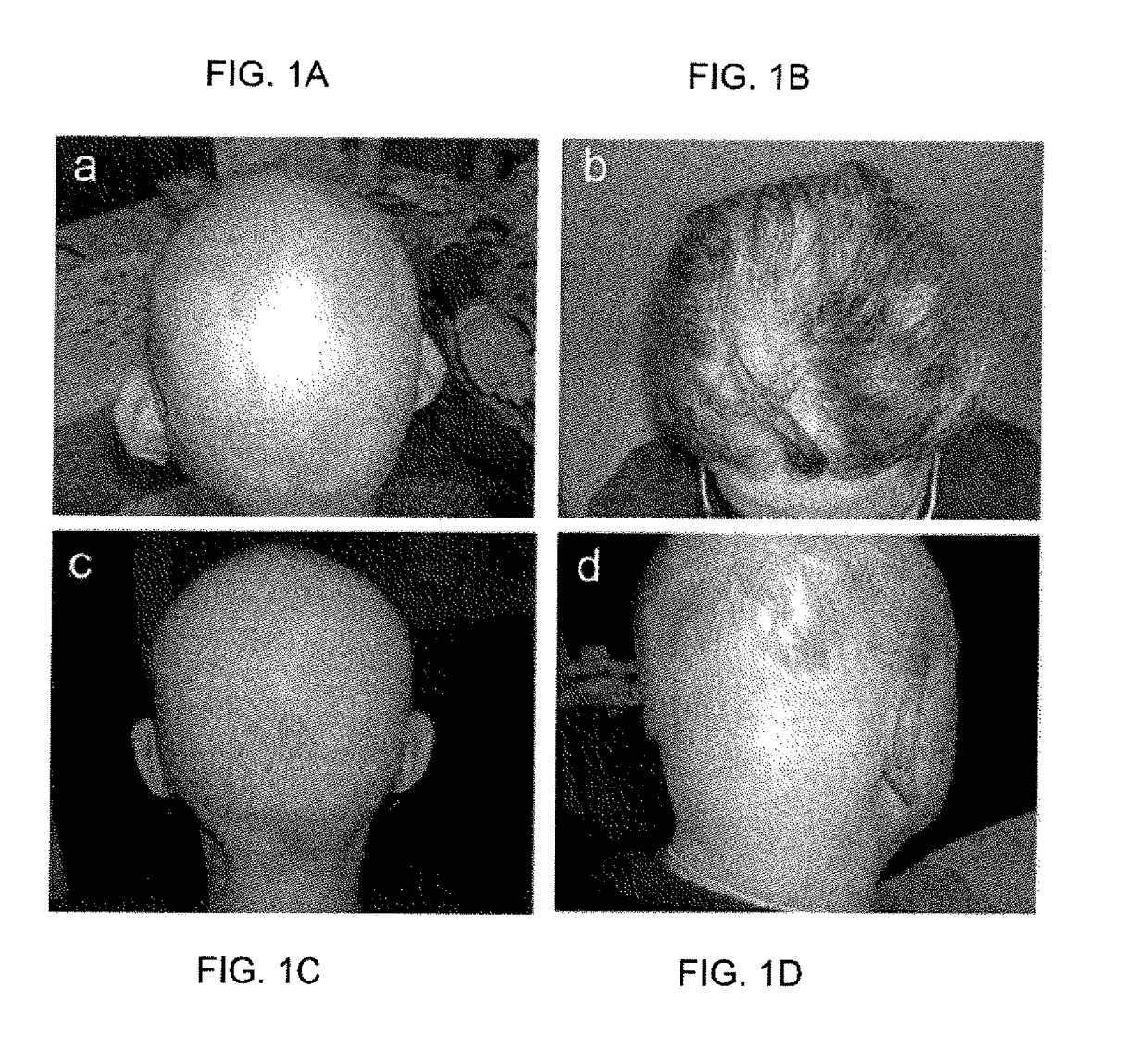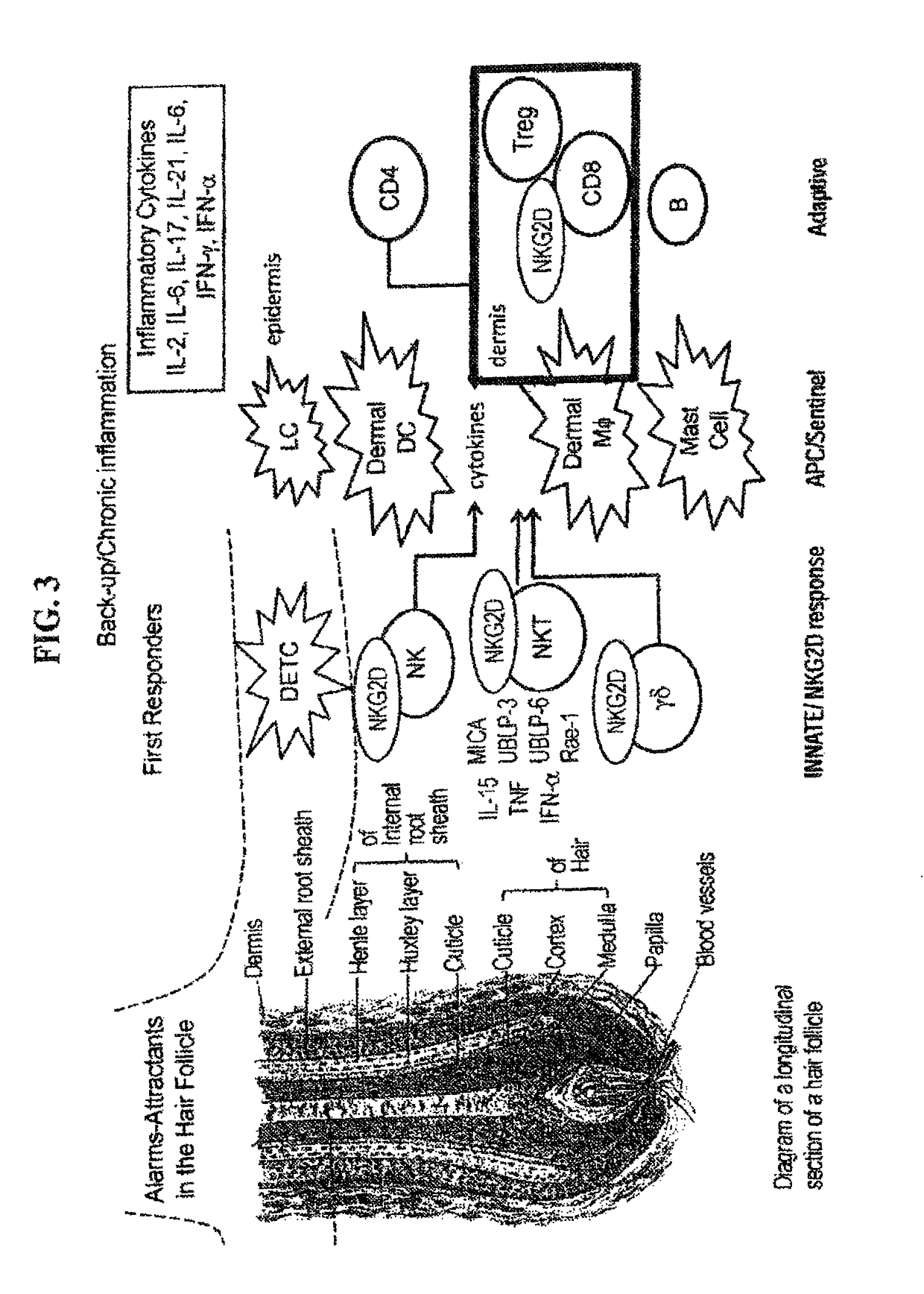Methods for treating hair loss disorders
a hair loss and disorder technology, applied in the field of hair loss disorders, can solve the problems of progressing to complete hair loss on the head or body, gene level diagnosis and rationally targeted therapeutics have not been developed, and the psychological impact of affected patients is devastating
- Summary
- Abstract
- Description
- Claims
- Application Information
AI Technical Summary
Benefits of technology
Problems solved by technology
Method used
Image
Examples
example 1
[0345]Interferon γ has been shown to be a target in murine AA (see Nakamura, et al. 2008, Am J Pathol, 172(3): 650-658; see also Freyschmidt-Paul et al., Br J Dermatol., 155(3):515-521; see also Gilhar et al., Journal Invest. Dermatol., 124(1):288-289). In human AA, AA PBMCs show Th1 skewing, AA skin shows IFN signature and GWAS genes (SOCS / IFN-g / ).but also IL-2 / 6 / 13 / 21 / 26.
[0346]The interferon γ pathway (FIG. 7) induces NKG2DL in target HF cells, enhances antigen presentation by DCs, promotes Th1 cellular autoimmunity and augments NK and CTL mediated-cytolysis.
[0347]JAK1 / 2 inhibitors in clinical development include a) INCB018424, topical and oral; 5 nM activity (Incyte); b) CEP-701 (Cephalon); and c) TG101348.
[0348]
[0349]
TABLE 4INCB18424-203: Treatment-Emergent Adverse Events in Descending Order(all casualties)(oral delivery is considered an acceptable profile)VehicleActiveMedra Preferred Term(n = 50)(n = 149)Application site irritation, pruritus7 (14.0)14 (9.3)Nasopharyngitis1 (2.0...
example 2
[0364]The following genetic studies will be performed:[0365]A replication study with another 1000 AA patients[0366]Deep sequencing of candidate regions[0367]Collection of 10,000 patients[0368]Common Genetic Studies T1D, CeO and AA[0369]An immunology study using NK activating ligands will be performed using ULBP3, ULBP6-inducible transgenics, new mouse models.
[0370]
TABLE 9Genes with Nominal Significance on the GWAS studiesCount ofMin p-valueMin p-valueGeneMbSNPs −4observedimputedAutoimmune ReportsGO classificationChromosome 2HDAC4240.0318.10E−055.59E−05inflammatoryresponseChromosome 3CACNA2D355.0217.28E−051.47E−05CeDChromosome 5IL13132.0221.87E−06Asthmaimmune responseChromosome 6HLA-G29.9411.07E−044.54E−06RA, MS, SLE, PS, T1D, Asthma,immune responseHLA-A30.0111.00E−042.72E−05MS, T1D, PS, GD, Asthma, Vitilagoimmune responseMICB31.5921.89E−051.97E−05MS, T1D, UC, RA, CeD, Asthmaimmune responseTAP232.9116.42E−061.28E−05T1D, RA, SLE, PS, GDimmune responseChromosome 7IL622.7227.72E−054.84E...
example 3
ples, Genotyping, Quality Control and Population Stratification
[0372]Alopecia areata (AA) is a major medical problem and is the most prevalent autoimmune disease in the US (Table 11), affecting approximately 4.6 million people, including males and females across all ethnic groups, with a lifetime risk of 1.7% (Kyriakis K P, Paltatzidou K, Kosma E, Sofouri E, Tadros A, Rachioti E. Alopecia areata prevalence by gender and age. J Eur Acad Dermatol Venereol. 23:572-3, 2009). Additionally, AA represents the second most common form of human hair loss, second only to androgenetic alopecia, and causes significant disfigurement and psychological distress to affected individuals (FIG. 1). AA affects more individuals than most other autoimmune diseases combined, including lupus erythematosus (LE), type 1 diabetes (T1D), psoriasis, multiple sclerosis (MS) and rheumatoid arthritis (RA) (Table 11).
[0373]
TABLE 11Automimmune Disease PrevalenceAutoimmune DiseaseRate per 100,000Alopecia Areata1700Pso...
PUM
| Property | Measurement | Unit |
|---|---|---|
| body weight | aaaaa | aaaaa |
| hair loss-disorder | aaaaa | aaaaa |
| body weight | aaaaa | aaaaa |
Abstract
Description
Claims
Application Information
 Login to View More
Login to View More - R&D Engineer
- R&D Manager
- IP Professional
- Industry Leading Data Capabilities
- Powerful AI technology
- Patent DNA Extraction
Browse by: Latest US Patents, China's latest patents, Technical Efficacy Thesaurus, Application Domain, Technology Topic, Popular Technical Reports.
© 2024 PatSnap. All rights reserved.Legal|Privacy policy|Modern Slavery Act Transparency Statement|Sitemap|About US| Contact US: help@patsnap.com










